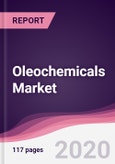The publisher’s analyst has estimated the global oleochemicals market to have had a value of $26.57 billion in 2020. And, as per the oleochemicals market analysis conducted by the report, the market demand is projected to grow at a CAGR of 4.9% during the forecast period (2020-2025).
Oleochemicals Market Outlook:
Various basic oleochemical substances such as fatty acids, fatty acid methyl esters, fatty alcohols, fatty amines, and glycerols are formed through chemical and enzymatic reactions. Intermediate chemical substances are also obtained from these chemicals namely alcohol ethoxylates, alcohol sulfates, alcohol ether sulfates, glycerols, and monoacylglycerols. Fatty acids are the major application of oleochemicals that have a noticeable demand from pharmaceutical, food and beverage industries, soap and laundry detergent, waxes, lubricant, candles, and paints and coatings. Surfactants, dispersing agents, wetting agents, emulsifying agents, solvents, and adjuvants are some of the vital inert ingredients produced by using these oleochemicals. Surfactants preparation is one of the prominent end use application of oleochemicals which is utilized in the making of detergents and household cleaning products as well.
Oleochemicals Market Segment Analysis:
Soaps and detergents application is dominating among diverse applications; it is estimated to grow with a CAGR of 4.8% during the forecast period 2020-2025. Massive developments associated with the largest plantations of oil palms in Southeast Asia marked the boom of the oleochemical industry. Southeast Asian countries such as Malaysia, Indonesia, and Thailand are spurring the oleochemical industry in the Asia-Pacific region. In Malaysia, there were 19 oleochemical plants with an annual processing capacity of 2.67 million tonnes in 2020. Its utilization rate increased to 94.9% from 85.2% compared to the previous year. In 2020, more palm based oleochemical products are exported from Malaysia to China and the U.S. due to the increasing demand from these countries, out of which fatty acids were majorly exported that is 0.99 million tonnes which holds a share of 35.1% among other types. Asia-Pacific is depicted by the analyst of the report as the largest oleochemicals producing region which holds a major share of about 41% in the global oleochemicals market size as of the year 2020.
Oleochemicals Market Trends and Drivers:
- The continued push to replace petrochemical-based solutions; new uses, and applications based on green chemicals are driving the growth of oleochemicals market revenue.
- Oleochemicals investment opportunities within and beyond Asia-Pacific region and stronger vertical integration offered by raw material based companies are fuelling the rationalization opportunities.
- Rapid growth in the production of palm oil and kernel oil is one of major factors in oleochemicals market growth. Reliable, efficient, and cost effective oleochemical plants are poised to cater to incrementing demands.
- There is an increase in the adoption of bio-based lubricants which are replacing synthetic and traditional lubricants in order to improve the efficiency of vehicles. This has bolstered the oleochemicals market size by many folds.
- Recent advancements in these chemicals lead to new applications in polymers and bio-surfactants in addition to soaps and detergents.
- There are growing number of investments from global companies such as Emery Oleo, Wilmar, and BASF in the oleochemicals market.
- Adoption of oleochemicals is increasing from diverse range of industries as they want to avoid environment pollution.
Oleochemicals Market: Competitive Analysis
- Emery Natural Oleochemical, Oleon, Wilmar International, Kuala Lumpur Kepong Berhad, and IOI Oleo GmbH are the key players holding major oleochemicals market shares. On the other hand, Clariant AG, BASF SE, Croda International, P&G Chemicals, Dow Chemials, and Vanatge Specialty Chemicals Inc. are major derivative manufacturing companies.
- In 2020, BASF SE experienced a 7% increase in sales of care chemicals. Increased prices of oleochemical surfactants and fatty alcohols reflected a positive effect on sales growth for the same year.
- Oleon opened a new isostearic acid unit in 2020, which is a significant piece of oleochemical technology and it enables an innovative solution for high-end applications namely cosmetics.
- In 2020, Wilmar implemented Inventure Supercritical Technology in China. This technology is aimed to produce fatty acid methyl esters for oleochemicals and also to manufacture bio-based oleochemicals.
- P&G Chemicals provide oleochemicals, which are used as inerts and adjuvants in agrochemical applications. These oleochemicals products are widely used in lubricants, metal works, and textile applications
- Emery Natural Oleochemical’s new product innovation named as EMEROX Polyols. It provides increased efficiencies and sustainability with improved performance properties to the end users. It also acts as an effective raw material in the manufacturing process of polyurethane products which is a significant material used in the automobile and construction industry to make foams.
Oleochemicals are the chemicals which are extracted from plants and animal fats or oils. Growing demand for biodegradable products is making a positive impact on the adoption rate of these chemicals. They have wide range of applications in soaps and detergents, food and beverage, household and personal care products, agriculture, automotive, and construction industries. These factors altogether are propelling the market growth in the near future.
Table of Contents
Methodology

LOADING...








